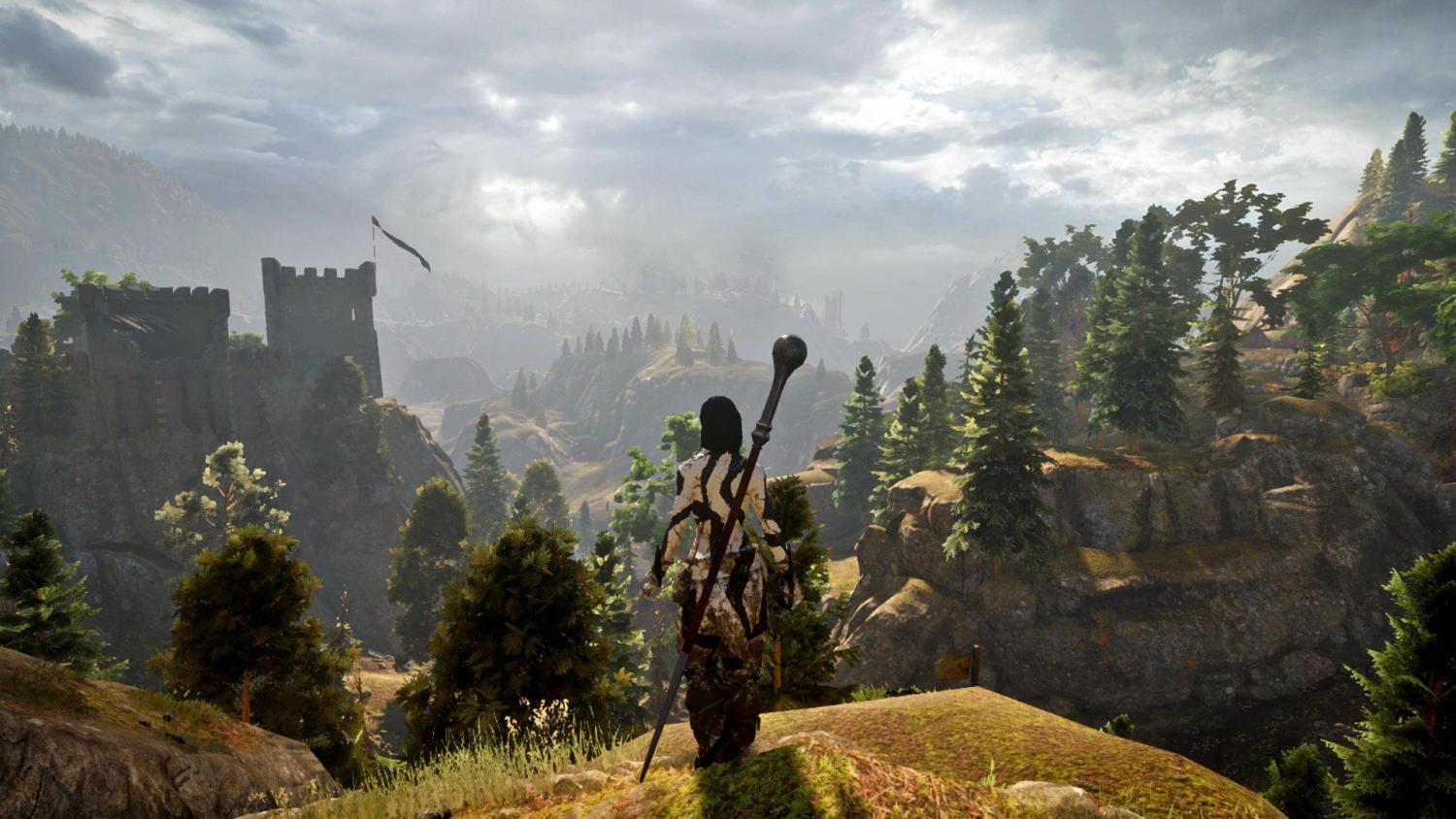
#OLMGamer Dives Back into Thedas in Dragon Age: Inquisition
In-game screenshots taken by Isabel Payne on Xbox One. All rights belong to Bioware.
After recently re-starting the Dragon Age: Inquisition campaign, I felt compelled to write about how much I adore this series as a whole, despite the third game being released almost three years ago. The Dragon Age series is one that is very dear to my heart and comes from a company where two of their titles dominate at my top three favourite games. Filled with vast amounts of lore, intriguing characters, and exciting combat, the Dragon Age series is one that I can (and have) replay multiple times and still discover new things. Set in the world of Thedas, where peace and quiet is something of a rarity thanks to rising tensions between mages and Templars, all-powerful baddies attempting to take over the world, and the occasional Blight, each Dragon Age game follows a different protagonist as they work to fix the most current problem. The series as a whole forces players to try and balance out combat, politics, and even relationships, where any small slip-up can change the course of the game.

Dragon Age: Inquisition is the third game in the Dragon Age series and it takes place shortly after the destructive ending of Dragon Age 2 where the mage/templar war begins. The game centers around the aftermath of events at the Temple of Sacred Ashes, where peace talks between the Mages and Templars are literally blown up by a mysterious antagonist called the Elder One. Large tears in the veil cause demons and other horrors to come spilling into the world, along with your character, who stumbles out of the Fade with a glowing green mark on their hand. The story then follows your character as they rise to lead the Inquisition to stop the Elder One and restore order to the world.
One of my favourite aspects of the game is the level of detail put into bringing a believable world to life. As you travel between Ferelden and Orlais, you’re not only greeted  with a difference in culture and politics, but with an expansive landscape which you can literally get lost in for hours (looking at you, Hinterlands). While the map is huge, it can be quite refreshing after playing the repetitive maps of Dragon Age 2. I adored exploring each area and seeing different parts of Thedas brought to life. Packed in each area are a multitude of side-quests for various groups and individuals which help bring you deeper into the Dragon Age world and learn more about its lore and people. These quests add all sorts of colours to the relatively dark Dragon Age palette, and while some players complained that it made the game far too long, I happily played through every single quest and collected every single collecatable the game had to offer.
with a difference in culture and politics, but with an expansive landscape which you can literally get lost in for hours (looking at you, Hinterlands). While the map is huge, it can be quite refreshing after playing the repetitive maps of Dragon Age 2. I adored exploring each area and seeing different parts of Thedas brought to life. Packed in each area are a multitude of side-quests for various groups and individuals which help bring you deeper into the Dragon Age world and learn more about its lore and people. These quests add all sorts of colours to the relatively dark Dragon Age palette, and while some players complained that it made the game far too long, I happily played through every single quest and collected every single collecatable the game had to offer.
Gameplay is especially enhanced by Trevor Morris's gorgeous soundtrack, whose composition style is vastly different from that of Inon Zur, who composed for the first two games. The orchestra is powered by a strong string and percussion section, as well as a sneaky choir supporting the whole ensemble, creating a perfect soundtrack for a fantasy RPG. While some tracks are meant to draw ambience into the game without drawing your attention to it while exploring, much of the soundtrack goes well beyond being simply background music and can effectively give you the essence of the story of Dragon Age: Inquisition on its own. Just listening to the main theme fills me with waves of nostalgia for the woody Hinterlands or the comforting stone walls of Skyhold. It pumps me up for adventure, danger and new discoveries, and I think that is what Dragon Age is all about.
While the game’s combat and variety of enemies are definitely impressive, I find it is the story itself which kept me captivated throughout the entirety of the game and kept me captivated to play more so that I can learn more. While the focus is on your Inquisitor, they are not over-powered protagonists who can do everything on their own. Dragon Age has always been about facing a calamity with a team of close companions and this team work really shines in Inquisition where the Inquisitor is often knocked down by their enemies, only to be held back up by their team. There is a large focus on building a strong team, but also to get to know them and build their trust in you and with each other. The game is packed with meaningful cutscenes and tough choices that will affect how they perceive you and whether or not they will stay with the Inquisition. These cutscenes also let you get to know other members of your team better. My personal favourites were cutscenes with Cassandra, who is usually stoic and hot headed, where players can learn about a completely different side to her when she’s not busy being a Seeker.
 I also enjoyed the level of freedom I was given when creating my character. Customization is a HUGE factor in the game, as it is afterall, an RPG. You can customize your character to be one of four races (human, dwarf, elf, or kunari), one of three character classes (rogue, mage, or warrior) and even within those classes, customize their weapon choices and even their character’s voice. I spent over an hour meticulously creating the perfect look for my Inquisitor, but those who don’t care for appearances can select a preset appearance and jump right into the game. Customization also continues throughout the game where you can choose specializations for your character class, select specific perks and abilities when leveling up, and even tint armour to be the exact colours you want it to be. Now you can head into battle with flair!
I also enjoyed the level of freedom I was given when creating my character. Customization is a HUGE factor in the game, as it is afterall, an RPG. You can customize your character to be one of four races (human, dwarf, elf, or kunari), one of three character classes (rogue, mage, or warrior) and even within those classes, customize their weapon choices and even their character’s voice. I spent over an hour meticulously creating the perfect look for my Inquisitor, but those who don’t care for appearances can select a preset appearance and jump right into the game. Customization also continues throughout the game where you can choose specializations for your character class, select specific perks and abilities when leveling up, and even tint armour to be the exact colours you want it to be. Now you can head into battle with flair!
One big upgrade from Dragon Age 2 is the game's combat system. Players can now choose between a couple different combat systems, whether they prefer to fight in real-time, or even whether or not their team mates are given autonomy in battle, or are given commands by the player. Due to the vast variety of enemies, the player must change their combat style and make sure they have the correct team make-up to better fit the situation. Each companion has a different fighting style and is of a different character class, making some more ideal for certain enemy types than others, so having a proper team setup is important.
Dragons were also finally given a humongous makeover and have become beautiful, glorious, and mighty beasts which loom massively over your character should you attempt to slay one. Each area is inhabited by a different dragon whose attack style and powers differ from each other. Due to the changing landscape, as well as the landscape changed by the dragon itself, any attempt to slay one must be done strategically. This is where the game’s tactics screen really shines and you can control each team member and command them to attack specific parts of the dragon’s body. Take out its leg and the dragon will stumble, or work with a teammate to create devastating combo attacks. In my first playthrough, I made the mistake of trying to take on a dragon without being properly prepared and got my whole team killed almost instantly. After leveling my Inquisitor up a bunch and crafting powerful new weapons, my second attempt at slaying a dragon still took me 40 minutes to do. I found battling dragons to be a lot more satisfying even than fighting the Elder One at the end of the main campaign.

Dragon Age: Inquisition has been out since 2014 and has received numerous well-deserved Game of the Year awards. We recommend picking up the Game of the Year edition which comes complete with all of the game’s expansions and DLCs and believe me, the expansions are definitely worth playing, especially the Trespasser expansion. The game has three expansions you can download, two of which are playable during the main campaign, while the final one is only playable once you complete the main story. Each expansion brings you to a different location and are filled with new quests, discoveries, and a whole new slew of problems. If you can only choose one to buy however, be sure to play Trespasser and prepare yourself for the feels. Trespasser answers some, but not all, of the many questions that came up thanks to that cliffhanger cut-scene at the end of the main campaign, as well as adding in a few new questions that will hopefully be answered in future games. Solas fans, don't expect this expansion to fix that broken heart though.










